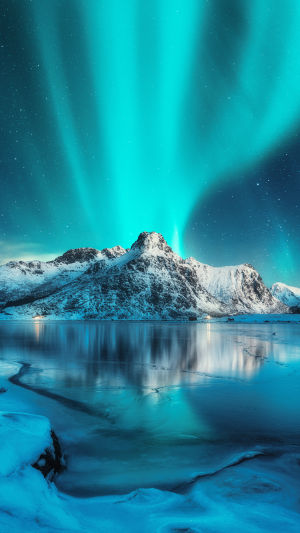Aurora is a mysterious and spectacular natural phenomenon. It can display various colorful colors and shapes in the night sky, making people feel the magic and beauty of nature.
The Earth possesses a magnetic field formed by the natural magnetic field generated by the liquid outer core inside the Earth. This magnetic field encloses the Earth in a region called the magnetosphere, which extends approximately from the Earth's surface to an altitude of thousands of kilometers.
Auroras are light phenomena that occur near polar regions within the magnetosphere. When the sun's charged particles (solar wind) enter the magnetosphere, they collide with gas molecules in the earth's atmosphere, causing changes in the excitation energy levels of the gas molecules, resulting in the phenomenon of luminescence. These glows can be observed at high latitudes, including regions near the North and South Poles.
In general terms, the magnetosphere is part of the Earth's magnetic field, and auroras are light phenomena that occur near the poles within the magnetosphere.
The world's most famous aurora phenomena occur in the Arctic and Antarctic regions. Here are some famous auroral phenomena:
Aurora Borealis: The phenomenon of the Northern Lights in the Arctic region, often referred to as the "Aurora Borealis". It is a stunning natural spectacle that often displays colors like green, purple, pink, and white in the sky.
Aurora Borealis: The phenomenon of the Aurora Borealis in the Antarctic region, similar to the Northern Lights, is also a stunning natural spectacle, often displaying colors such as green, purple, pink, and white in the sky.
Abisko, Sweden: Abisko in northern Sweden is one of the ideal locations for aurora viewing. The weather conditions here are stable, with a good chance of clear nights, and activities such as dog sledding and snowshoeing are also available.
Iceland: Iceland is considered one of the best places to observe the aurora. It is located near the Earth's magnetic poles, so you can see very beautiful auroras. In addition, Iceland is also rich in natural landscapes such as volcanoes and hot springs, making it a very popular tourist destination.
Yellowknife Town, Canada: Yellowknife Town, Canada is also a very suitable place to observe the aurora. The Aurora Festival is held here every year, attracting tourists from all over the world to watch this natural wonder.
If you're planning to go to an aurora viewing area to observe the aurora, here are some things to prepare:
Arrange your travel time: The best time to observe the aurora is usually in the evening and early morning, and the night sky needs to be clear. It is best to choose a time between autumn and winter to avoid too strong daytime light at night in summer, which can prevent observation.
Choose the right location: Choosing a location free of light pollution can improve your chances of seeing the aurora. It is usually best to choose remote areas farther from the city, such as mountains, rural areas, lakes, and other places.
Wear the right clothing: Aurora viewing requires spending time outdoors, so wear warm, comfortable clothing and shoes, preferably gloves, a hat, and other accessories.
Prepare photography equipment: If you want to take photos of the aurora, you need to prepare a camera with high sensitivity, a tripod, and other photography equipment. When taking pictures outside, it is best to wear gloves to prevent the camera from getting too cold and causing battery power loss or damage to the device.
Book accommodation and transportation: Since the aurora observation sites are usually in remote areas, it is necessary to book accommodation and transportation in advance to ensure the safety and comfort of the journey.
In some cultures, the aurora is regarded as a sacred existence, representing auspiciousness, peace, and happiness. Therefore, watching the aurora also has certain cultural and spiritual connotations.





